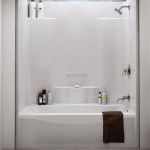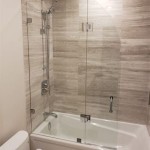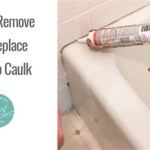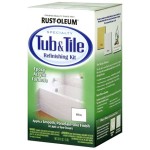Best Mildew Resistant Bathtub Material 2024
Selecting the right bathtub material is crucial for ensuring longevity, maintaining hygiene, and minimizing maintenance efforts. In 2024, the focus has shifted towards materials that inherently resist mildew growth, a common concern in moist bathroom environments. This article delves into the best mildew-resistant bathtub materials currently available, examining their properties, benefits, and potential drawbacks.
Mildew thrives in warm, damp conditions, making bathrooms an ideal breeding ground. Traditional bathtub materials can be susceptible to mildew colonization if not properly cleaned and maintained. Porous surfaces, in particular, provide ample opportunity for mildew spores to take root and multiply. Choosing a material with inherent mildew-resistant properties can significantly reduce the likelihood of this problem, simplifying bathroom upkeep and promoting a healthier environment.
Several factors contribute to a bathtub material's mildew resistance. These include its porosity (or lack thereof), its surface texture, and its chemical composition. Non-porous materials leave mildew spores with nowhere to penetrate and take hold. Smooth surfaces make it more difficult for mildew to cling and easier to clean. Some materials are also treated with antimicrobial agents or naturally possess chemical properties that inhibit mildew growth.
Acrylic Bathtubs with Antimicrobial Coatings
Acrylic bathtubs have gained popularity due to their affordability, versatility in design, and relatively lightweight nature. However, standard acrylic can be susceptible to mildew growth if not properly maintained. To address this, many manufacturers now offer acrylic bathtubs with antimicrobial coatings. These coatings are designed to inhibit the growth of bacteria and mildew on the surface of the tub.
The antimicrobial coatings typically involve the incorporation of substances like silver ions or other biocides into the acrylic material. These substances continuously release small amounts of antimicrobial agents, preventing mildew spores from colonizing the surface. The effectiveness of these coatings can vary depending on the specific formulation and the manufacturer's processes. It is essential to research reputable brands and read reviews to ensure the coating's efficacy and longevity.
While acrylic bathtubs with antimicrobial coatings offer enhanced mildew resistance, regular cleaning is still necessary. The coating provides an extra layer of protection, but it does not eliminate the need for routine maintenance. Using non-abrasive cleaners and regularly wiping down the tub after use helps prevent the buildup of soap scum and other organic matter that can provide a food source for mildew.
One key advantage of acrylic is its ability to be repaired relatively easily. Scratches or chips can often be buffed out or filled, extending the lifespan of the tub and preventing potential entry points for mildew. This reparability makes acrylic a more sustainable choice compared to materials that require complete replacement when damaged.
The cost of acrylic bathtubs with antimicrobial coatings is generally higher than standard acrylic tubs, but the added protection and reduced maintenance requirements can justify the investment. The extended lifespan and improved hygiene also contribute to long-term cost savings.
Solid Surface Bathtubs
Solid surface materials are another excellent option for mildew-resistant bathtubs. These materials are typically composed of a blend of natural minerals and resins, creating a non-porous, homogenous surface. The absence of pores prevents mildew spores from penetrating the material, making it highly resistant to growth.
Solid surface bathtubs are known for their durability and seamless appearance. The lack of grout lines eliminates potential hiding places for mildew and simplifies cleaning. The smooth, non-porous surface also makes it difficult for soap scum and other residues to adhere, further reducing the risk of mildew growth.
The manufacturing process of solid surface materials allows for a wide range of design possibilities. Bathtubs can be molded into various shapes and sizes, accommodating different bathroom layouts and aesthetic preferences. The color is consistent throughout the material, so scratches and minor damage are less noticeable and can often be repaired easily.
While solid surface materials are highly mildew-resistant, they are not entirely immune to staining or discoloration. Certain harsh chemicals can potentially damage the surface, so it is important to use appropriate cleaning products recommended by the manufacturer. Regular cleaning with mild soap and water is typically sufficient to maintain the tub's appearance and prevent the buildup of dirt and grime.
Solid surface bathtubs are generally more expensive than acrylic or fiberglass tubs, but their superior durability, mildew resistance, and aesthetic appeal make them a worthwhile investment for many homeowners. The long-term cost savings associated with reduced maintenance and extended lifespan can offset the initial higher price.
Brands like Corian, Swanstone, and LG Hausys HI-MACS offer a variety of solid surface bathtub options. Each brand has its unique formulations and design styles, so it is essential to compare the different products and choose the one that best suits your needs and preferences.
Cultured Marble Bathtubs with Gel Coat
Cultured marble is a composite material made from crushed marble mixed with resins and pigments. It is then coated with a gel coat, a layer of resin that provides a smooth, non-porous surface. The gel coat plays a crucial role in the bathtub's mildew resistance.
The gel coat acts as a barrier, preventing moisture from penetrating the cultured marble underneath. This barrier is essential because cultured marble itself can be somewhat porous. A well-maintained gel coat will resist mildew growth and staining effectively. However, if the gel coat is damaged or scratched, moisture can seep into the cultured marble, creating an environment conducive to mildew.
Cultured marble bathtubs are generally more affordable than solid surface options, making them a popular choice for budget-conscious homeowners. They offer a good balance of aesthetics, durability, and mildew resistance when properly cared for.
Maintaining the gel coat is crucial for preserving the bathtub's mildew resistance. Avoid using abrasive cleaners or scouring pads, as these can scratch the surface and compromise the integrity of the gel coat. Regularly cleaning with mild soap and water is sufficient to remove dirt and grime. If the gel coat does become damaged, it can be repaired professionally to restore its protective properties.
The aesthetic appeal of cultured marble lies in its ability to mimic the look of natural marble at a lower cost. It is available in a wide range of colors and patterns, allowing homeowners to create a luxurious-looking bathroom without breaking the bank. However, it's important to note that cultured marble typically doesn't feel as substantial as natural stone or solid surface materials.
It's vital to research the quality of the gel coat used in cultured marble bathtubs. A thicker, more durable gel coat will provide better protection against mildew and wear and tear. Look for products from reputable manufacturers that offer warranties on their gel coat finishes.
In summary, when choosing a bathtub material for optimal mildew resistance in 2024, consider acrylic with antimicrobial coatings, solid surface materials, or cultured marble with a high-quality gel coat. Each option offers varying degrees of protection, durability, and aesthetic appeal. Regular cleaning and proper maintenance are essential for maximizing the mildew resistance of any bathtub material.
Cost is also a factor. While solid surface materials are the most mildew resistant and often the most durable, they can be quite expensive. Acrylic tubs with antimicrobial coatings offer a middle ground, balancing cost and mildew resistance. Cultured marble can be a budget-friendly option, but requires meticulous maintenance of the gel coat to prevent mildew issues.
Ultimately, the best choice depends on individual needs, budget, and aesthetic preferences. Understanding the properties of each material and considering the specific bathroom environment will help in making an informed decision that ensures a clean, healthy, and mildew-free bathing experience.

Best Bathtub Material And What Each Costs 2024 Modernize

Best Bathtub Material And What Each Costs 2024 Modernize

Best Bathtub Material And What Each Costs 2024 Modernize

Best Bathtub Material And What Each Costs 2024 Modernize

Best Bathtub Material And What Each Costs 2024 Modernize

Best Bathtub Material And What Each Costs 2024 Modernize

Best Bathtub Material And What Each Costs 2024 Modernize
:max_bytes(150000):strip_icc()/Spruce-best-bathtubs-4178494-V1-6794c3fa4ee44e9c8925583c64f6ebe0.jpg?strip=all)
The 11 Best Bathtubs Of 2024

Toxin Free Bathtubs Healthy House On The Block
Guide For Freestanding Tubs Signature Hardware
Related Posts







